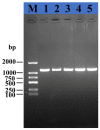Screening Method and Antibacterial Activity of 1,3,4-Oxadiazole Sulfone Compounds against Citrus Huanglongbing
- PMID: 37445692
- PMCID: PMC10341523
- DOI: 10.3390/ijms241310515
Screening Method and Antibacterial Activity of 1,3,4-Oxadiazole Sulfone Compounds against Citrus Huanglongbing
Abstract
Citrus Huanglongbing (HLB) is one of the most destructive diseases in the citrus industry. At present, Candidatus Liberibacter asiaticus (CLas) cannot be cultured in vitro, and there is a lack of rapid methods to test antibacterial activity, which greatly hinders the discovery of new antibacterial agents against HLB. To establish a rapid screening method for antibacterial agents against HLB with simple operation, a short cycle, and a large number of tests, the CLas contents in leaves from different citrus branches, different leaves from the same citrus branch, and two halves of the same citrus leaf were detected. Compared with the leaves on different branches and different leaves on the same branch, the difference in CLas content of the left and right halves of the same leaf was small; the difference was basically between 0.7 and 1.3. A rapid and efficient method for primary screening agents against HLB termed the "half-leaf method" was established through our long-term optimization and improvement. To verify the stability and reliability of the activity data measured using this method, 6-chloropurine riboside, which is highly soluble in water, was used as the test agent, and its antibacterial activity against HLB was tested 45 times. The results of the antibacterial activity test showed little difference in the mean values of each data group, indicating that this method could be used as a rapid method for screening agents against HLB. We used this method to test the antibacterial activity of compounds synthesized by our research group against HLB and found that some of the compounds showed good activity.
Keywords: Citrus Huanglongbing; antibacterial activity; antibacterial agent; rapid screening method.
Conflict of interest statement
The authors declare no conflict of interest.
Figures





Similar articles
-
Quercus leaf extracts display curative effects against Candidatus Liberibacter asiaticus that restore leaf physiological parameters in HLB-affected citrus trees.Plant Physiol Biochem. 2020 Mar;148:70-79. doi: 10.1016/j.plaphy.2020.01.013. Epub 2020 Jan 12. Plant Physiol Biochem. 2020. PMID: 31945669
-
Progress and Obstacles in Culturing 'Candidatus Liberibacter asiaticus', the Bacterium Associated with Huanglongbing.Phytopathology. 2019 Jul;109(7):1092-1101. doi: 10.1094/PHYTO-02-19-0051-RVW. Epub 2019 Jun 3. Phytopathology. 2019. PMID: 30998129 Review.
-
'Candidatus Liberibacter americanus', associated with citrus huanglongbing (greening disease) in São Paulo State, Brazil.Int J Syst Evol Microbiol. 2005 Sep;55(Pt 5):1857-1862. doi: 10.1099/ijs.0.63677-0. Int J Syst Evol Microbiol. 2005. PMID: 16166678
-
Spatiotemporal Dynamics of 'Candidatus Liberibacter asiaticus' Colonization Inside Citrus Plant and Huanglongbing Disease Development.Phytopathology. 2021 Jun;111(6):921-928. doi: 10.1094/PHYTO-09-20-0407-R. Epub 2021 Jul 19. Phytopathology. 2021. PMID: 33174821
-
Citrus huanglongbing: a newly relevant disease presents unprecedented challenges.Phytopathology. 2013 Jul;103(7):652-65. doi: 10.1094/PHYTO-12-12-0331-RVW. Phytopathology. 2013. PMID: 23441969 Review.
Cited by
-
Design, synthesis, and antibacterial activity of novel amide derivatives containing a sulfone moiety.Mol Divers. 2025 Feb 11. doi: 10.1007/s11030-024-11088-0. Online ahead of print. Mol Divers. 2025. PMID: 39934575
References
-
- Joseph M.B. Huanglongbing or yellow shoot, a disease of Gondwanan origin: Will it destroy citrus worldwide. Phytoparasitica. 2014;42:579–583. doi: 10.1007/s12600-014-0415-4. - DOI
-
- Bove J.M. Huanglongbing: A destructive, newly-emerging, century-old disease of citrus. J. Plant. Pathol. 2006;88:7–37.
-
- Lopes S.A., Luiz F.Q.B.F., Martins E.C., Fassini C.G., Sousa M.C., Barbosa J.C., Beattie G.A.C. ‘Candidatus Liberibacter asiaticus’ Titers in Citrus and Acquisition Rates by Diaphorina citri Are Decreased by Higher Temperature. Plant. Dis. 2013;97:1563–1570. doi: 10.1094/PDIS-11-12-1031-RE. - DOI - PubMed
MeSH terms
Substances
Grants and funding
- 2021YFD1400800/the National Key R & D Program of China
- QKHJC-ZK (2022)039/the Natural Science Foundation of Guizhou Province
- NO. 2022115/Scientific Research Project of Guizhou Provincial Education Department (Young Project) (NO. 2022115)
- NO. 202101/the Natural Science Foundation of Guizhou University
LinkOut - more resources
Full Text Sources
Other Literature Sources

